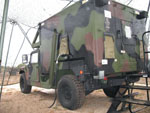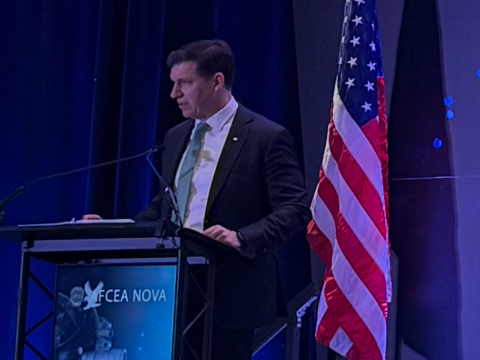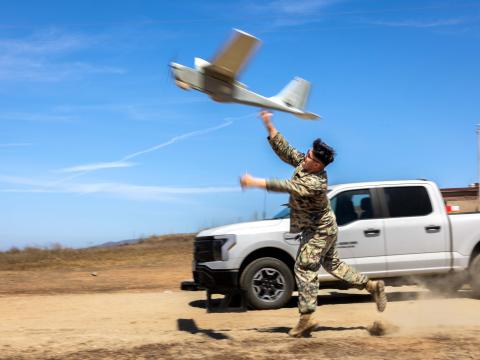Building Command and Control, One Node at a Time
 |
| An element of the Common Aviation Command and Control System (CAC2S) is undergoing developmental testing at U.S. Marine Corps Tactical Systems Support Activity (MCTSSA), Camp Pendleton, California. The Marine Corps expects to field the system in fiscal year 2008. |
The U.S. Marine Corps is assessing a technology that will allow troops to assemble aviation command and control centers anywhere they can take a high mobility multipurpose wheeled vehicle (HMMWV). The new system is more agile, mobile and dynamic than the systems it replaces, and it gives Marines the ability to engage the enemy more quickly and effectively.
The Common Aviation Command and Control System (CAC2S) comprises a series of subsystems, or nodes, that can be combined to provide operational-level command and control (C2), applied independently to fill a specific need or used at stages between those two extremes. Each node is mounted on a HMMWV and serves as one of the three specific subsystems—a processing and display subsystem, a sensor data subsystem or a communications subsystem. The three subsystems combine to create one full C2 system. The CAC2S integrates hardware, software, datalinks, sensors and global planning equipment to provide robust C2 with state-of-the-art technology that replaces legacy systems.
The CAC2S provides a common system for all Marine Corps aviation C2. At present, C2 functions such as air support operations, air defense operations and air space management are performed using a variety of equipment, each component requiring specific training and maintenance. With the new technology, the Marine Corps can leverage commonality in its capabilities. The system also enables Marines to become more responsive because they will not have to wait for new equipment to arrive to carry out a new function. In the future, a node could be used for one mission on a given day then applied to another mission later the same day. Marines would have to reconfigure crews for operational changes, but they would not need to modify equipment. Down the line, the Marine Corps may do more cross-training with crews, so fewer changes in personnel would be necessary.
According to Col. Peter Reddy, project manager, Marine Air-Ground Task Force (MAGTF) Command and Control Development Division, “The CAC2S will enable a lot more flexibility in employment in the battlespace.” The colonel is assigned to the Marine Corps Systems Command, Marine Corps Base Quantico, Virginia. Col. Reddy also states that the CAC2S is the MAGTF’s foundation system or capability for the transformation of aviation C2.
The Marine Corps accepted delivery of 15 HMMWV-mounted subsystems from prime contractor Raytheon Company,
Col. Reddy says that in addition to improving air C2, the Marine Corps wants to provide better C2 to all function areas. The next phase is using the CAC2S as one of several foundational components for the MAGTF strategy to transform C2 from air to ground for more commonality and modularity.
“Modularity, scalability and flexibility are the three bumper stickers we try to associate with CAC2S as much as we can,” the colonel explains.
The thrust behind the Marines’ strategy is reduction of the number of separate systems used for C2. This will lead to better interoperability and digital information sharing between the air and ground for an improved operational picture. To realize this goal, another phase of CAC2S development involves moving the system into the joint arena and interfacing with C2 capabilities across the joint battlespace.
For now, the system benefits Marines in several ways. The components that troops need to fight a battle are now together in a single place instead of coming in from different locations. The CAC2S provides the information needed to act rapidly in a situation, allowing air C2 to be more responsive for aviation commanders as well as for troops on the ground. Richard C. Herriott, CAC2S program manager, Raytheon, observes that in the past Marines might have a datalink at one position, a ground picture somewhere else and communications at a different site. “Since that’s integrated [in the CAC2S], they have a complete tactical picture at one location,” he says. “They have one-stop shopping for command and control, which improves their overall situational awareness.” The system integrates fires, maneuverability and aviation into a single air picture.
Another benefit to the warfighter is the system’s mobility. By mounting the CAC2S on a HMMWV, Marines can create a command post anywhere by driving the vehicles to the desired location and connecting the equipment. Troops then have a command center from which they can start vectoring aircraft and providing overall C2. The operators work in user support equipment (USE) tents hauled in trailers by the HMMWVs. In the tents, Marines have laptops and a large screen display and operate the equipment and capabilities in the CAC2S shelters. The technologies on the HMMWVs and in the USE tent are interconnected.
The mobility allows Marines to transfer C2 nearer to a threat, placing troops at closer range and permitting them to meet the line-of-sight requirements inherent in some equipment. If troops push an enemy back, they can follow and move the CAC2S instead of keeping the capabilities in a static location. In contrast, some current C2 centers are set up in 20-foot International Organization for Standardization shelters. The CAC2S leaves a much smaller footprint.
By using the CAC2S, Marines bring their own network and infrastructure to a location. The three subsystems provide local direct air support capability and full C2. If a commander decided to expand a mission to a theaterwide level, the Marines might need to expand their capability, which could require additional nodes. Commanders would decide which elements were needed to support local, regional or theater operations, and troops could configure the nodes to meet those purposes.
“It’s modular, it’s scalable, and you can build on that based on threat and location,” Herriott explains.
 |
| Marines assigned to the MCTSSA and the Marine Air Command and Control System Experimental Operational Development Team test the CAC2S at Camp Pendleton. |
Developers built the system from an idea on paper into the robust system the Marines have today. “This is a brand new system, a brand new platform from the ground up,” Herriott states. The developers also designed the CAC2S to support open architecture for future integration.
Raytheon worked with several subcontractors on the CAC2S, including Sensis Corporation, East Syracuse, New York; Gallium Software Incorporated, Ottawa; Kongsberg Gruppen ASA, Kongsberg, Norway; Ternion Corporation, Huntsville, Alabama; and General Dynamics C4 Systems, Scottsdale, Arizona.
Herriott describes the system as robust and complex yet extremely capable. Marines can perform tasks such as controlling aircraft, managing datalinks, communicating by radio and providing close air support simultaneously.
Datalinks allow CAC2S users to share their air picture and C2 with ships and aircraft, where the necessary equipment already resides. Herriott says the vision is to integrate the CAC2S with vessels at sea and to provide a ground picture. Much of the functionality, software and capabilities on board ships were used in the creation of the CAC2S, which increases the likelihood of success in interoperability.
Raytheon trains Marines on the new system, familiarizing them with the software and functions and teaching them which buttons to push and the sequence of keystrokes to execute certain commands. The training focuses on equipping Marines to use this system to conduct their normal missions. Raytheon has two primary training schools, one for operators and the other for maintenance personnel.
The service is interested in cross-training Marines to take on more than one function and is examining issues related to training and efficiency. Col. Reddy says that developers are building the CAC2S to allow a single Marine to take on as many missions as possible. Testing and development personnel are working with operational forces to find the best application of the system on the battlefield.
In terms of manpower, Col. Reddy estimates that system administrators will have many more capabilities to manage with the CAC2S because it involves an increase in network centricity over old systems. The CAC2S also may require new maintenance specialties.
Col. Reddy states that the CAC2S will improve Marines’ responsiveness in planning and execution. Troops in the theater will be linked with the MAGTF and the joint force, enabling more integrated planning and reactive execution.
The colonel expects commanders also will have greater flexibility using the CAC2S for concepts such as distributed operations. Each node can adjust for new missions more rapidly than could systems in the past. Marines will have the speed and flexibility to bring the right capability to the right part of the battlespace. “Increasing the tempo is going to really increase our success in the battlespace in the future,” he shares.
Web Resources
Raytheon Company: www.raytheon.com



Comments